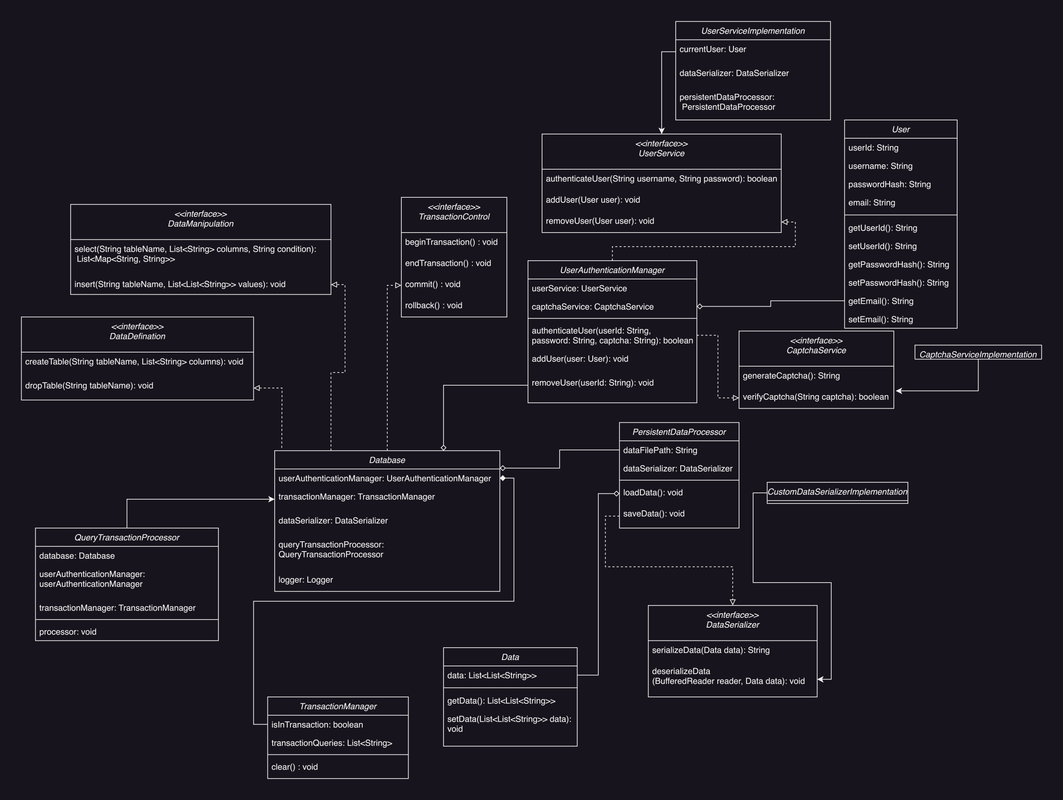Hey, code fans!
We all know MySQL is great, but what if I told you we can make our own simple database management system? Yes, you heard right. This blog is all about making a DBMS with our own changes, starting from scratch.
First things first
Building a custom database can be a tricky business. If we dive in without a plan, we might find ourselves tangled in a web of messy code that’s not only inefficient but also becomes a nightmare to manage as we move forward.
So, how do we steer clear of this chaos? The answer is simple - by starting with a solid design for our classes and setting up clear relationships between them. To give you a bird’s eye view of the whole setup, here’s a class diagram that lays out the entire structure of the application. This should give you a good sense of how all the pieces fit together.
Breaking Down the Database Management System
Our database management system is divided into three key processes:
- Parsing: This is where we handle the parsing of the query and validate its syntax. It's all about making sure the query is well-formed and ready to go.
- Executing: Next up is the execution phase. Here, we bifurcate the query based on its type and make the appropriate call to the database.
- Fetching: Finally, we have the fetching process. This is where we retrieve the data from the database (in our case, files) and deliver it to the end user.
And there you have it! A clear, easy-to-follow breakdown of our database management system.
Working of the Database (the interesting part)
Database Application Overview
Our application uses a file storage system for the database. Here's a closer look at its structure and functionality.
File Structure
The database consists of three types of files:
1. users.csv
This file holds all the user data, including details of existing users. When a new user is added to the database, their information is stored here. This file is critical as all user logins are handled using it.
2. database.log
This file records all the activities in the database. It tracks the operations performed and the user who is currently logged in and performing these operations.
3. Table-specific files
When a table is created in the system, a corresponding file with the same name as the table is created. This file stores all the information related to that table.
Custom Delimiter
The system uses a custom delimiter -_- for serializing and deserializing the files in the database. This unique delimiter helps in accurately reading and writing data to and from the files.
Supported Commands
The application supports the following DDL and DML commands:
-- CREATE TABLE
create table <table_name> (<column_name>, <column_name>);
-- CREATE USER
create user <username> identified by <password>;
-- SELECT
select * from <table_name>;
-- or
select <column_name> from <table_name>;
-- or
select <column_name> from <table_name> where <condition>;
-- INSERT
insert into <table_name> values (value, value), (value, value), (value, value);
Transaction Support
The database also supports transactions and ensures ACID properties. Here are the transaction-related commands:
BEGIN TRANSACTION: This command starts a new transaction.END TRANSACTION: This command ends a transaction.COMMIT: This command saves the queries in the transaction to the file.ROLLBACK: This command discards all changes made by queries and restores the previous consistent state of the database.
Novelty
In our quest for continuous improvement, we've implemented a feature that measures the execution time of each query in milliseconds. This is our very own profiling tool that provides valuable insights into the performance of each query.
With this tool, we can identify bottlenecks and optimize the system for better performance. It's like having a microscope that lets us zoom in on any performance issues and address them effectively. So, here's to a faster, more efficient database system!
NOTE:
Just a quick heads up! When you're logging into the database for the very first time, you'll need to use the root user credentials. Here they are:
- User ID:
1 - Password:
admin
Don't worry, this is just for the first time. 🙌
Once you're in, you can go ahead and create your own user profile. From then on, you can use your own credentials. It's as simple as that! 😄
Link to the Source Code.
Happy coding! :))
